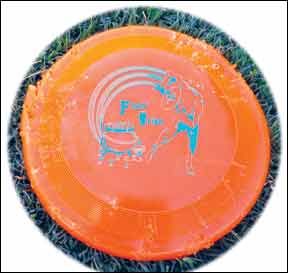[Updated February 6, 2019]
I used to live with a Frisbee-addicted dog (a Border Collie named Rupert), and a disc-addicted son, who is now off at college (and still addicted). So how is it that Whole Dog Journal has never before reviewed flying disc toys for dogs?

There is a wide variety of flying toys made for dogs, with different key features for different applications. The overarching concept is to create a disc that flies well enough to inspire a dog to chase it, catch it, and return with it uninjured. Most of us owners want a toy that won’t be ruined within three catches between a dog’s teeth, but you don’t want it to be so tough that it can hurt a dog’s teeth or mouth if he doesn’t catch it perfectly.
We enlisted three types of product testing “dogs” to help with the review. The first are disc-throwing experts, including my son; he’s co-captain of a college Ultimate team called (get this) the (University of California) Davis Dogs. He enlisted some of his teammates to test-throw a number of dog discs and report on the products’ flying abilities. The second set of reviewers are professional disc dog competitors (canine/human teams). Our third set of reviewers are backyard dogs who love fetching flying things.

Frisbee Throwability vs. Safety
Engaging the services of an Ultimate team to test flying discs for dogs is not as bizarre as it sounds. This spring, the Davis Dogs were one of 20 teams nationally that qualified for and competed in the USA Ultimate (USAU) College National Championships (for the first time in the Dogs’ 31-year history!).
A special disc is used in the game of Ultimate – and even though the sport is often informally called “Ultimate Frisbee,” discs made by Frisbee haven’t been used in the game for more than 20 years. Discraft is maker of the official disc of USAU, the sport’s governing body in this country, and its 175-gram “Ultrastar” is the only disc used in official tournaments of all levels. It’s far heavier than grocery-store Frisbees, with a thick, weighty rim that helps it fly farther than a lighter disc – and that can bruise your knuckles and crush your fingernails if you don’t catch it just so.
Discs made for playing with dogs are usually much lighter than the discs made for Ultimate. It’s one thing when an Ultimate player hurts his or her hand (or accidentally takes a disc in the face when trying to block a competitor’s throw) in their favorite game, but it’s unconscionable to ask your dog to play a game that can hurt him (even if it’s his favorite, too). If a disc gets blown by the wind or a dog slips as he is leaping for the disc, or he simply miss-times his jump, a heavy or too-rigid disc can break a tooth, or knock him in the gums, jaw, or head hard enough to really hurt. So, most discs for dogs are either very light or made out of a soft material.

That’s great for safety, but discs made of light weight or soft materials don’t fly nearly as far as harder, heavier discs – and gummy discs are really difficult to throw accurately. This isn’t a problem if you’re playing in the middle of a great big field, but if you are trying to throw the disc in competition so that your dog catches it in a certain spot, accuracy is important. And if you use fetch games as a primary method for tiring (or conditioning) your dog, you want a disc that can be thrown as far as possible. Also, if you’re like me, with a compromised shoulder that limits how far I can throw anything, you appreciate a disc that can be flung a long distance with a minimum of effort.
In the Davis Dogs’ throwing tests, they found that the ability to fly far was almost always paired with an increased potential to hurt dogs. And, in general, the discs that flew poorly are the soft or floppy ones made with safety for dogs foremost in mind. Fortunately, we found a happy medium.
What Are the Best Frisbee Disc for Dogs?
I was lucky in having the Davis Dogs nearby to test-throw discs; I was even luckier in having disc dog expert Steve Teer nearby, to offer his feedback on various discs. Steve and his wife, Jill, live in Vacaville, California. Steve has been a disc dog fanatic ever since he first saw a disc dog competition on TV in 1998. “I was hooked,” says Steve. “I had an Australian Shepherd, Guinness, who was about 18 months at the time. I decided to see if I could teach him some of the tricks I saw on TV.” Steve found a disc dog club in his area and entered his first competition with Guinness the following month.
Since then, Steve has won numerous championships in every type of disc dog competition with his dogs, starting with Guinness (who passed away in 2011), continuing through Irish (born in 2004 and recently retired from competition), and including Steve’s newest Aussie superstar, Whiskey. His youngest dog, Whiskey recently qualified for the 2012 Ashley Whippet Invitational World Championships at the tender age of 22 months old (the competition will be held in September in St. Louis). Whisky also won the Freestyle Flying Disc competition at the Purina Pro Plan Incredible Dog Challenge in Del Mar, California, in June.
Further, Steve is just a hell of a nice guy, welcoming to newcomers and longtime disc dog enthusiasts alike, and generous with his time and expertise. He seems to get a special enjoyment from introducing newbies to the sport; it’s a good way to share some of his dog-friendly training tips and philosophy, and his passion for keeping his dogs safe and happy. “These dogs sleep with me and my wife every night; they are our family members,” he told me. “I would never do anything to hurt or scare my dogs, and if they ever show me that they are not having fun, we stop what we’re doing.”

Teer starts his disc dogs as puppies on floppy fabric flying discs, which can be thrown for short distances and safely used as tug toys. Short sessions of tug-of-war increase a dog’s interest in and enthusiasm for discs, so he keeps some of the floppy discs around for tug and for novelty, but graduates a pup to very lightweight plastic flying discs. Like the Davis Dogs, Teer is not a big fan of the floppy rubberized discs often sold in chain pet supply stores; while they have a low potential for hurting a dog, they don’t fly far or accurately. Once a pup or young dog shows enthusiasm for flying discs, Teer introduces them to very lightweight but rigid discs, which are easy to throw accurately and have a low potential for hitting a dog hard enough to hurt him or make him lose interest in the game.
These lightweight, rigid discs are particularly susceptible to being punctured by enthusiastic dog teeth, however – and once a disc has been punctured, it has great potential for cutting a dog’s mouth and a thrower’s hand. You definitely don’t want your dog to catch rigid plastic discs that have been badly chewed – and they are not much fun to throw, either. When a dog bites a rigid disc – especially one of the lightweight discs – it punches raised, sharp cones of plastic on one side of the disc. Catching a spinning disc covered with these sharp projections is like trying to clasp a thorn-covered rose stem; it’s almost impossible to make a secure catch without getting hurt.
When a disc gets too chewed or pierced to work with safely, Teer discards it. That’s why, like many disc dog devotees, Teer buys the lightweight (105 or 110 grams) discs in bulk; he goes through about 500 a year! (Plus, the companies that make discs for disc-dogs events offer custom imprinting, so when Teer places those orders, the discs arrive with his “team” logo, “Flyin’ Irish.”)
There are alternatives in the form of slightly softer (though still rigid), bite-resistant discs. Companies that specialize in products especially for dog sports have developed some discs that are, in our opinion, juuuust right for the average dog owner with a moderately disc-obsessed dog. The rubberized discs resist punctures, but are rigid enough to fly well and light enough to reduce hard knocks.

Of course, dog owners can be fussy and opinionated about gear for their preferred sports, and disc dog people are no different. Some competitors prefer the rigid discs, even if they have to go through a lot of them. Some want to use only the discs used in competition, so both they (the thrower) and their dogs have a consistent experience with the discs. For his part, Teer worries that it’s harder on the dogs’ jaws to repeatedly bite a resistant material. “This is my own theory, and it’s not at all scientific: I just worry where all that biting and chewing energy goes. I’m concerned that the dog’s jaws end up absorbing a lot of the energy of the bite, potentially harming the dog’s teeth and the muscles in the jaw,” he explains. He also hastens to explain that he has no data to support his concerns; it’s pure speculation on his part.
Then again, his dogs chomp on discs every single day. For the average backyard disc chaser, the more durable discs are a blessing, since they last a long time without sprouting the sharp plastic “thorns” caused by canine punctures.
Whole Dog Journal‘s Favorite Frisbee
So, while we recognize that some of these discs excel in certain applications (noted in the individual disc reviews, below), our top pick in flying discs for a puncture-resistant, excellent-flying disc that will best serve to thoroughly exercise a dog without knocking out his teeth or consciousness, is the 145-gram, bite-resistant Jawz disc made by Hyperflite, a company that specializes in equipment for disc dog sports. You won’t find them in grocery stores or even pet supply discount chains, but they can be found in select independent pet supply stores and online retailers of disc dog equipment, such as skyhoundz.com.
The Jawz disc is heavier than the most popular disc dog discs, but lighter by far and more rigid than most of the discs meant for casual dog play and designed to prevent injuries to the dog. Of course – surprise! – it costs a lot more than the lightweight (practically disposable) discs made by the same company. We paid $16.95 for a Jawz disc, whereas the Hyperflite “Competition Standard” model was just $3.58 from skyhoundz.com. But then, we expect to be able to use it for a long, long time.
Prices for the “amateur” flying toys varied quite a bit, too. We paid from $9 to $25 for the various toys and discs we found in retail pet supply stores, but didn’t find any that really suited either our dogs or the Davis Dogs.
One final note: None of these flying fetch toys are meant to resist a serious chewing session; do not leave your dog unsupervised with any of them.






